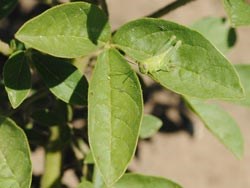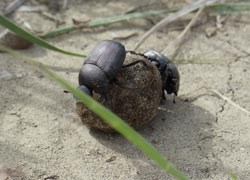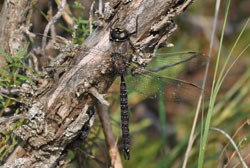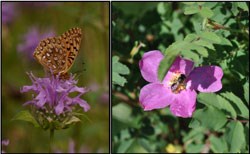
NPS photo by Laura Thomas The tiny world of insects makes up a big part of Theodore Roosevelt National Park. Most people do not like bugs; they never stop to think what an important role they have in an ecosystem. We are going to get out our magnifying glass and take a closer look at the world of bugs! First, we need to learn that not all bugs are insects. An insect is a class, like a mammal or reptile. All insects have six legs, three body parts, and usually have wings. They are part of a much bigger group of critters called arthropods. This group includes all kinds of bugs like spiders and centipedes. Arthropods do not have skeletons, which is why they are in a different group from mammals, reptiles and birds. 
NPS photo by Joe Bruce Balls of What? One of the craziest insects we have is the dung beetle. The life of this beetle is all about dung! That's right: scat; feces; poop! If it sounds gross, that's because it is! This insect will gather up dung by rolling it into a ball. The male and female work to find a place to bury their dung. The beetle lays eggs inside of the dung for the young to feed on when they hatch. It is very thoughtful to prepare such a great first meal! It is pretty gross to us humans, but the dung beetles are important to the ecosystem. By "planting" dung, they actually help the soil plants need to grow. Flies feed on mammals by biting them; these flies need dung to lay their eggs, so dung beetles help bison by removing the dung those pesky flies might use! 
NPS photo by Joe Bruce Jet Fighters of the Insect World Lots of insects are herbivores. Some (like that dung beetle) are decomposers. A decomposer eats decaying matter. Some insects specialize in eating other insects! There is a special term for this: insectivorous. One example is the dragonfly. Like many insects, dragonflies go through a metamorphosis. This means they have different stages of life where they change from one form to another. You might think of the giant bug that zooms through the air, but a dragonfly starts its life underwater! This underwater form is called a nymph. Dragonflies live in this form for months or even years! When they are ready to change, they crawl out of the water. Like a butterfly coming out of its cocoon, the dragonfly emerges. To see some awesome pictures of a nymph turning into a dragonfly, check out this website made by a friend of the park! A dragonfly lives in this form for only a few weeks. It can be spooky to have a huge insect fly by you, but dragonflies are good for humans. They buzz around eating flies, mosquitoes, and even other dragonflies! 
NPS photos by Jeff Zylland and Joe Bruce Pollinators Insects help humans in lots of ways we do not think about. If we did not have insects, many of the plants we enjoy and depend on would not survive. Plants need animals like bees and butterflies to spread their pollen. Pollen is like a seed, but it only has part of the next flower generation. Insects feed on nectar, which is a liquid found in a flower. When they feed, pieces of pollen get stuck to their bodies. That pollen gets moved to other flowers as the insect flies around. This lets the flower reproduce. The bee needs the plant to eat, and the plant needs the bee to reproduce. When two organisms help each other, they have a relationship called mutualism! We spent a long time researching insects! There are thousands of beetles, flies and grasshoppers in the park. Bugs might be creepy for some people, but our next group of animals can really scare people! We will do some research about reptiles and amphibians to learn why they aren't so scary after all. You can also go back to the main wildlife page or you can return to the first Learn About the Park page. Go to the vocabulary page to review the blue words you learned here. |
Last updated: August 21, 2015
